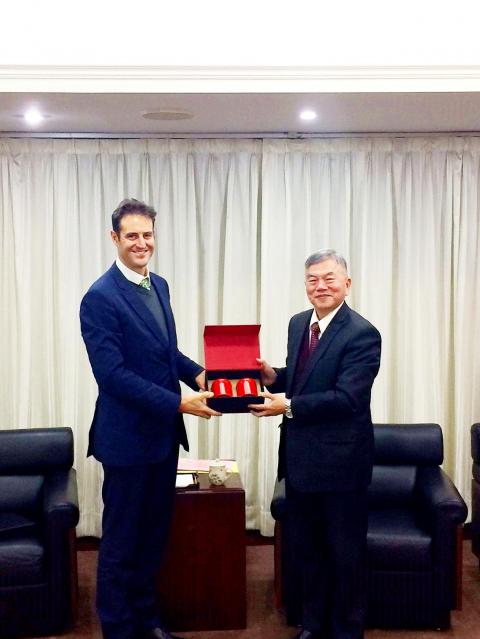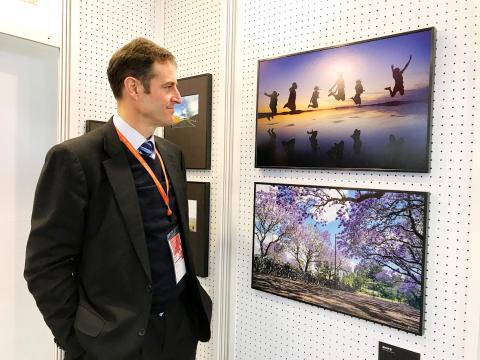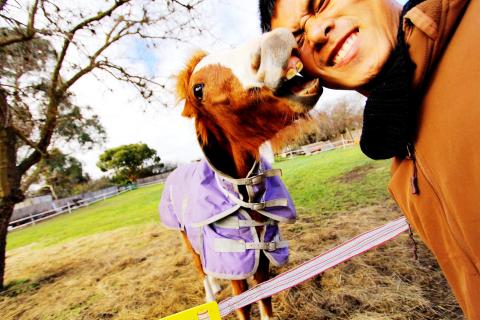When Ross Maddock led an Australian delegation to meet President Tsai Ing-wen (蔡英文) the day after her inauguration in 2016, the first topic she raised was pension reform.
“I told her that we can do this,” says Maddock, former head and council member of the Australia-Taiwan Business Council. Maddock told Tsai that Australia has both the governmental experience to set up an efficient superannuation system and the business know-how to create new services around that system that will boost the finance sector.
Indeed, Australia was ranked first in the world in Allianz’s 2016 Pension Sustainability Index.

Photo courtesy of Australia Office Taipei
Gary Cowan, the newly appointed Representative Designate of the Australia Office Taipei, says Australia is known here mostly as a resources supplier and a great holiday destination, but adds that the country has a lot more to offer Taiwan. Central to his vision for expanding the two countries relations in the years ahead is raising Australia’s profile as a partner for collaboration in an ever widening range of fields.
“The timing’s great,” Cowan says. “Australia is looking north to the Indo-Pacific right at the same time that Taiwan is looking south through its New Southbound Policy… There is a policy symmetry that’s going to work for us.”
GREEN and GOLD ENERGY

Photo courtesy of Australia Office Taipei
Australia, one of Taiwan’s biggest energy providers and its largest supplier of thermal coal, is now looking to provide greener alternatives to Taiwan’s transforming energy sector.
Cowan applauds the major energy reforms Taiwan is currently undergoing and says the transition challenges faced by the nation, especially power reliability and pricing, mirror Australia’s own experience.
He says his country has a lot to share with Taiwan both commercially and in terms of policy.

Photo courtesy of Chen Hu-jun
“Our [renewable energy] companies have an enormous amount of skill… and a commitment to Taiwan which has been enabled by the determination of the [Taiwanese] government to move into this arena,” Cowan says.
Australia’s liquefied natural gas exporters and renewable energy companies stand to benefit from new opportunities opening up in Taiwan’s shifting energy market.
Maddock says many Australia-Taiwan business council members are keen to get involved with new opportunities in Taiwan’s energy sector and names Macquarie Taiwan as one example which has evolved its investment strategy, becoming an operator of windfarms and solar plants.
In 2016, the Australian multinational announced plans to invest US$791 million, becoming the chief stake holder in the Formosa 1 offshore wind farm project.
Cowan says Australia’s strength in scientific research and biotechnology also has great potential to compliment Taiwan’s efforts to develop its biotech sector into an engine of innovation.
Indeed, already the Taiwan Blood Services Foundation (台灣血液基金會) regularly sends blood to Australia to create blood preparations for medical use in Taiwan. As the world’s leading plasma producer, the firm audits the blood service’s laboratories in Taiwan, which are also approved by the Australian government’s Therapeutic Goods Administration.
Maddock says there are many more opportunities like this in the biotech sphere, cancer treatment and hearing-aid technology having particular potential.
FOSTERING NETWORKS
The two countries have also begun to collaborate on agriculture research projects. Last year, Taiwan Agricultural Research Institute signed a Memorandum of Understanding with the Queensland state government and sent four local varieties of lychee to be grown in tropical state, taking advantage of the complementary climates to extend the fruit’s short growing season.
Maddock says joint-projects like this should be a priority for Australia as Taiwan’s superiority in tropical and subtropical horticulture is undisputed.
Yet despite these promising developments, it seems building awareness in Taiwan of the potential for partnership with Australia remains a challenge.
“We [Australia] shut Taiwan off for a long time,” says Maddock, referring to decades of little to no diplomatic contact that began after Australia ended formal ties with Taiwan in 1972.
He adds that although migration, travel and direct flights in recent years have greatly improved levels of understanding, some gaps still remain.
Cowan aims to close these gaps by fostering communities of Taiwanese who have a strong Australian connection. The trade office recently established an Australian alumni association and held a photo competition for returned working holiday makers.
The alumni association has already created some very special connections — a newly wedded couple who first met at an alumni get-together recently gifted the Australia Office a box of customary cookies and thanked them for creating the opportunity for them to meet.
Building upon the joint lychee research project, a young farmers exchange program was launched last year with a group of Australian fruit growers coming to learn farming techniques for lychees and bananas in Taiwan. Cowan says the second round is getting under way with a Taiwanese cohort heading to Australia later this year.
“In looking south, we hope Taiwan thinks of Australia in a broader range of fields than it has before,” Cowan says.
Australia will have to work hard to have Taiwan see it as a natural partner in sectors where the two countries’ collaboration has been previously limited, especially in service sectors outside of education and tourism, such as finance or healthcare. Yet being included in the New Southbound Policy rubric may offer Australia just the chance it needs to refashion its image and give Taiwan’s government and business leaders cause to head even further south — down under.

May 26 to June 1 When the Qing Dynasty first took control over many parts of Taiwan in 1684, it roughly continued the Kingdom of Tungning’s administrative borders (see below), setting up one prefecture and three counties. The actual area of control covered today’s Chiayi, Tainan and Kaohsiung. The administrative center was in Taiwan Prefecture, in today’s Tainan. But as Han settlement expanded and due to rebellions and other international incidents, the administrative units became more complex. By the time Taiwan became a province of the Qing in 1887, there were three prefectures, eleven counties, three subprefectures and one directly-administered prefecture, with

Taiwan Power Co (Taipower, 台電) and the New Taipei City Government in May last year agreed to allow the activation of a spent fuel storage facility for the Jinshan Nuclear Power Plant in Shihmen District (石門). The deal ended eleven years of legal wrangling. According to the Taipower announcement, the city government engaged in repeated delays, failing to approve water and soil conservation plans. Taipower said at the time that plans for another dry storage facility for the Guosheng Nuclear Power Plant in New Taipei City’s Wanli District (萬里) remained stuck in legal limbo. Later that year an agreement was reached

What does the Taiwan People’s Party (TPP) in the Huang Kuo-chang (黃國昌) era stand for? What sets it apart from their allies, the Chinese Nationalist Party (KMT)? With some shifts in tone and emphasis, the KMT’s stances have not changed significantly since the late 2000s and the era of former president Ma Ying-jeou (馬英九). The Democratic Progressive Party’s (DPP) current platform formed in the mid-2010s under the guidance of Tsai Ing-wen (蔡英文), and current President William Lai (賴清德) campaigned on continuity. Though their ideological stances may be a bit stale, they have the advantage of being broadly understood by the voters.

In a high-rise office building in Taipei’s government district, the primary agency for maintaining links to Thailand’s 108 Yunnan villages — which are home to a population of around 200,000 descendants of the Chinese Nationalist Party (KMT) armies stranded in Thailand following the Chinese Civil War — is the Overseas Community Affairs Council (OCAC). Established in China in 1926, the OCAC was born of a mandate to support Chinese education, culture and economic development in far flung Chinese diaspora communities, which, especially in southeast Asia, had underwritten the military insurgencies against the Qing Dynasty that led to the founding of